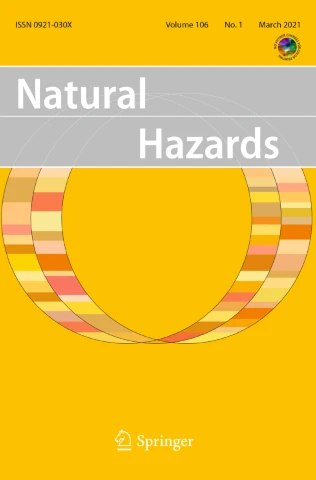‘Alternative Facts’: Ted Nordhaus explains how extreme events came to represent climate change contrary to an overwhelming scientific consensus
https://rogerpielkejr.substack.com/p/alternative-facts BY ROGER PIELKE JR. Excerpt: …[A]n excellent new essay by Ted Nordhaus of The Breakthrough Institute2 published today by The New Atlantis, titled — Did Exxon Make it Rain Today?. Nordhaus does a nice job explaining that disasters occur at the confluence of an extreme event and an exposed and vulnerable society, but most attention these days […]
STUDY: ‘Floods have become less deadly: an analysis of global flood fatalities 1975–2022’ – ‘The average number of fatalities per event has declined over time’

https://link.springer.com/article/10.1007/s11069-024-06444-0 Floods have become less deadly: an analysis of global flood fatalities 1975–2022 Published: 27 February 2024 – Natural Hazards Abstract Floods are amongst the most frequent disasters in terms of human and economic impacts. This study provides new insights into the frequency of loss of life at the global scale, mortality fractions of the population […]
Politico: ‘Green’ buildings face a flood of doubts – 800 U.S. buildings certified as ‘sustainable’ are at extreme risk of flooding — & may have to be abandoned
https://www.politico.com/newsletters/power-switch/2023/09/25/green-buildings-face-a-flood-of-doubts-00117900 By CORBIN HIAR More than 800 U.S. buildings certified as “sustainable” are at extreme risk of flooding — and may have to be abandoned as the planet continues to overheat. That’s because the U.S. Green Building Council — an influential nonprofit that works to make buildings more climate-friendly — has for years largely overlooked […]
Media is Wrong, the 2023 Burning Man Rainstorm Wasn’t Caused By ‘Climate Change’
https://climaterealism.com/2023/09/wired-and-the-conversation-are-wrong-the-2023-burning-man-rainstorm-wasnt-caused-by-climate-change/ By Linnea Lueken This year, the popular music festival Burning Man, which is held in the Black Rock Desert area of Nevada, was interrupted by a rainstorm that left many participants stranded. Wired and The Conversation, among other media outlets, attributed the rain storm, as well as the heat wave the area experienced a […]
New Studies Find No Global Drought Trend Since 1902 – Global Flood Magnitudes Decline With Warming
https://notrickszone.com/2023/08/14/new-studies-find-no-global-drought-trend-since-1902-global-flood-magnitudes-decline-with-warming/ By Kenneth Richard Anthropogenic Global Warming (AGW) is claimed to intensify hydrological processes. Data analysis indicates it does not. A paradigm has emerged in recent decades that says there has been and/or will be a worsening of hydrological extremes as a consequence of global warming. Simplified, the paradigm says that wet gets wetter (flooding) and […]
Media’s Constant Linking of ‘Extreme Weather’ to Climate Change is ‘Intellectually Dishonest Says Top U.S. Meteorologist
https://dailysceptic.org/2023/05/04/medias-constant-linking-of-extreme-weather-to-climate-change-is-intellectually-dishonest-says-top-u-s-meteorologist/ BY CHRIS MORRISON One of the top Western U.S. broadcast meteorologists hit out recently at “clickbait” stories that demonised every major weather event. Don Daly, often referred to as ‘Wyoming’s weatherman’ said that politicians, media and environmental group’s constant mantra that every national weather event is somehow the result of human activity, “is intellectually dishonest”. […]
Climate expert Dr. Roger Pielke Jr. slams ‘climate journalism’ & Lists Top 5 Media narratives – ‘A big part of climate reporting these days is simply climate advocacy’
https://rogerpielkejr.substack.com/p/top-five-climate-change-narratives Top Five Climate Change Narratives in the Media Coverage of climate has become more about narrative promotion than news By ROGER PIELKE JR. Source: University of Colorado Boulder I’ve seen a lot over the past three decades. For instance, I’ve seen my own research on climate go from being widely covered in the late 1990s […]
‘The State of the Climate 2022’ Report Finds ‘Little To Alarm’ -By Prof. Ole Humlum
https://mailchi.mp/52df827f135a/the-state-of-the-climate-195311?e=0b1369f9f8 The State of the Climate 2022 London, 12 April – In his annual review of the state of the global climate, Professor Ole Humlum finds much of interest to readers, but little to alarm them. There are some climate trends that support claims of climate concern – but many that do not. For example, Professor Humlum draws […]
‘Climate Brides’ – Media claims ‘Pakistan’s Climate Crisis of Child Marriage’ Due to Floods – ‘Patriarchal power structures impose disproportionate climate-related harms on women & girls’
https://newsletter.climatenexus.org/20230328-pakistan-child-brides-shell-nigerian-pollution-eia-2022 Climate Nexus: Floods Drive Increase In Number Of Pakistani Girls Sold Into Marriage – Floods Drive Increase In Number Of Pakistani Girls Sold Into Marriage: The catastrophic flooding that submerged one-third of Pakistan last year is driving an increase in the number of girls sold off as child brides there, Atmos reports. The increase, after child marriages […]
Definitive Guide to Extreme Weather: No trends or declining trends in hurricanes, floods, tornadoes, droughts, heat waves, disaster losses, wildfires – All peer-reviewed & official sources – By Dr. Roger Pielke Jr.
https://threadreaderapp.com/thread/1625530996958572545.html The Honest Broker by Roger Pielke Jr. Feb 14, 2023 • 18 tweets 🧵 What the media won’t tell you about extreme weather and its impactsHere is a thread of some of the figures I’ve posted in recent months about extreme weather that I have never seen in legacy media reportingAll peer-reviewed and official […]
